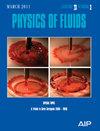Surface wettability and capillary flow of water in nanoslits of two-dimensional hexagonal-boron nitride
IF 4.1
2区 工程技术
Q1 MECHANICS
引用次数: 0
Abstract
The wettability and imbibition dynamics of water within 2-dimensional hexagonal boron nitride (h-BN) nanochannels were investigated through nanoscale molecular dynamics simulations. Results from the sessile drop and liquid plug methods indicate that the contact angle on h-BN is notably lower than that on graphene, with single-layer h-BN exhibiting greater hydrophobicity compared to multilayer h-BN. The disjoining pressure in liquid nanoplug was calculated to validate the Young–Laplace equation. During the imbibition process, the penetration length follows l2 = Slt. Simultaneously, the decrease in internal energy (ΔE) follows ΔE = −SEt1/2. While the Lucas–Washburn expression (l2 ∼ wt) can capture such behavior, it does not account for the dependence on channel width (w), where w = Nb, with N denoting the number of h-BN sheets and b the thickness. In wide nanoslits (N > 4), the penetration velocity decreases as the channel width increases. The final ΔE converge to the same value, and SE2/Sl remains constant. In narrow nanoslits (N ≤ 4), the penetration velocity does not decrease consistently with channel width. The final ΔE does not converge to a consistent value for N = 1, 1.5, and 2, and SE exhibits distinct trends with Sl. Comparisons reveal that water in h-BN nanochannels exhibits a notably higher imbibition velocity than in graphene due to differences in the driving force.二维六方氮化硼纳米片中水的表面润湿性和毛细流动
通过纳米级分子动力学模拟研究了水在二维六方氮化硼(h-BN)纳米通道中的润湿性和浸润动力学。无柄液滴法和液塞法的结果表明,h-BN 上的接触角明显低于石墨烯上的接触角,与多层 h-BN 相比,单层 h-BN 表现出更大的疏水性。计算了液态纳米插头中的分离压力,以验证 Young-Laplace 方程。在浸泡过程中,渗透长度为 l2 = Slt。同时,内能(ΔE)的减少遵循ΔE = -SEt1/2。虽然卢卡斯-沃什伯恩表达式(l2 ∼ wt)可以捕捉到这种行为,但它没有考虑到与通道宽度(w)的关系,其中 w = Nb,N 表示 h-BN 薄片的数量,b 表示厚度。在宽纳米通道(N > 4)中,穿透速度随着通道宽度的增加而降低。最终的 ΔE 收敛到相同的值,SE2/Sl 保持不变。在窄纳米its(N ≤ 4)中,穿透速度不会随通道宽度的增加而持续降低。在 N = 1、1.5 和 2 时,最终的 ΔE 值并不趋于一致,SE 与 Sl 呈明显的变化趋势。比较结果表明,由于驱动力的不同,水在 h-BN 纳米通道中的浸润速度明显高于石墨烯。
本文章由计算机程序翻译,如有差异,请以英文原文为准。
求助全文
约1分钟内获得全文
求助全文
来源期刊

Physics of Fluids
物理-力学
CiteScore
6.50
自引率
41.30%
发文量
2063
审稿时长
2.6 months
期刊介绍:
Physics of Fluids (PoF) is a preeminent journal devoted to publishing original theoretical, computational, and experimental contributions to the understanding of the dynamics of gases, liquids, and complex or multiphase fluids. Topics published in PoF are diverse and reflect the most important subjects in fluid dynamics, including, but not limited to:
-Acoustics
-Aerospace and aeronautical flow
-Astrophysical flow
-Biofluid mechanics
-Cavitation and cavitating flows
-Combustion flows
-Complex fluids
-Compressible flow
-Computational fluid dynamics
-Contact lines
-Continuum mechanics
-Convection
-Cryogenic flow
-Droplets
-Electrical and magnetic effects in fluid flow
-Foam, bubble, and film mechanics
-Flow control
-Flow instability and transition
-Flow orientation and anisotropy
-Flows with other transport phenomena
-Flows with complex boundary conditions
-Flow visualization
-Fluid mechanics
-Fluid physical properties
-Fluid–structure interactions
-Free surface flows
-Geophysical flow
-Interfacial flow
-Knudsen flow
-Laminar flow
-Liquid crystals
-Mathematics of fluids
-Micro- and nanofluid mechanics
-Mixing
-Molecular theory
-Nanofluidics
-Particulate, multiphase, and granular flow
-Processing flows
-Relativistic fluid mechanics
-Rotating flows
-Shock wave phenomena
-Soft matter
-Stratified flows
-Supercritical fluids
-Superfluidity
-Thermodynamics of flow systems
-Transonic flow
-Turbulent flow
-Viscous and non-Newtonian flow
-Viscoelasticity
-Vortex dynamics
-Waves
 求助内容:
求助内容: 应助结果提醒方式:
应助结果提醒方式:


